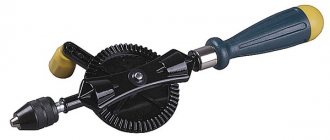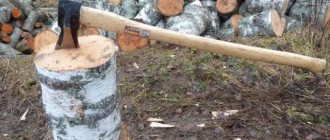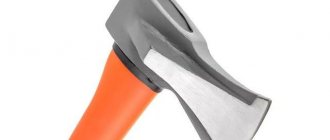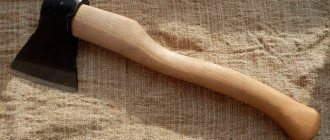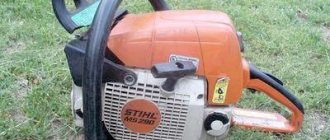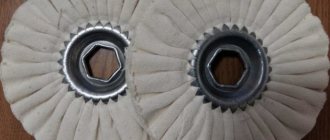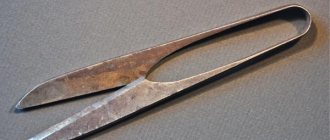Owners of country cottages, who heat their homes using a solid fuel boiler or stove, annually prepare up to 12 cubic meters of firewood, depending on needs. It will take several days to prepare such a volume. To speed up the process, you can make your own cleaver - a special device for mechanized chopping of wood.
A mechanized cleaver will speed up the time of chopping wood and also save your energy
Classification of devices for chopping wood
The cleaver has an extended handle (maximum 1 m). The angle is obtuse, reaching 70 degrees. It usually weighs from 2 to 3 kg. Its purpose is to split wood along the grain. There are several varieties of cleaver.
Spring cleaver
A spring model with a lever enhances the blow. A stand is placed under the blade. All materials are laid out on it. This tool is quite simple to use. Place a log under the blade with one hand and split it with the other.
The device consists of:
- frames based on a profile or round pipe with a horizontal elongated support;
- a lever that connects the support to the cutting element;
- lever spring fixed to the frame. With its help, the blow is strengthened;
- weight attached to the other side of the lever.
Mechanical spring cleaver.
Cleaver with electric motor
Tools with an electric motor have a higher cost. There is a need to purchase an electric drive with all the necessary components. These models can be:
- screw - the cutting element is made in the form of a metal cone with a blade. The thread is cut in the opposite direction from the movement of the shaft. The cone gets deep with the help of a screw and can split in half;
- having rack and pinion transmission. The design and operation of such devices is much more complex than the previous version. The blade is installed horizontally on the surface. A log is placed on one side, the gear rotates, compresses the blade and the block. A split occurs.
Hydraulic cleaver
The hydraulic model is the most expensive. The base frame is taken as a basis. The structure consists of:
- electric motor - hydraulic cylinder having high pressure;
- oil pump;
- oil tank with filter;
- cross-shaped blade;
- iron pusher.
Diagram of a hydraulic splitter.
Subtleties you should know when making a hand cleaver
It is worth considering the following nuances:
- the angle located at the handle should be sharper, and on the reverse side – obtuse;
- The sharpening angle is often combined.
Thus, the splitting becomes effective.
The sharp zone enters the wood. The thicker side penetrates deeply and increases the sliding impact.
By making a small number of blows, a large number of splits occur.
Electromechanical press for chopping wood
Another machine option is somewhat reminiscent of human work, that is, the preparation of wood fuel is carried out by impact, followed by wedging of logs. However, the difference is that the blow is applied in a horizontal direction to the log laid in the tray, which in turn collides with a wedge rigidly fixed at the end of the chute. Here, the source of impulse is an electric motor connected to a hydraulic cylinder, the piston of which creates a load of about 5 tons.
The advantage of such a splitting cleaver is that it is quite compact, since it is a frame mounted on two wheels with additional supports that ensure stability. Having moved the frame to the woodpile and given it a horizontal position, you connect the electric motor to the power source and lay the first log. Then all that remains is to press the large start button and turn the lever that holds the hydraulic mechanism in the starting position. As a rule, such units are made in such a way that you have both hands on the controls, in order to avoid attempts to hold the log in the chute, which will certainly lead to injury.
Materials
For the production of chopping parts it is appropriate to use:
- old ax (cracks are not allowed);
- spring element.
Hard wood is suitable for the handle.
The materials are prepared in advance. It is best to wait until the tree's sap flow stops. This will prevent tearing when drying.
The following tools are used in the work:
- grinder;
- sandpaper or file;
- hacksaw;
- hammer;
- knife;
- sometimes the inverter is welding.
Assembling the screw and hydraulic apparatus
A suitable engine with a speed of 500 rpm and a power of 1.5-2 kW will greatly simplify the design of the cleaver. This electric motor connects directly to the cone; there is no need to install a belt drive. If a unit with these characteristics cannot be found, prepare the following set of materials:
- 2 single-groove pulleys of calculated diameter, reducing the shaft rotation speed to 500 rpm;
- V-belt;
- bearing blocks and driven shaft;
- screw splitting cone made according to the drawing;
- profile pipes or other rolled products for making a table;
- electric motor mounting plate made of sheet 8-10 mm thick;
- metal 2-3 mm on the tabletop;
- mounting bolts and nuts.
Recommendation. Do not order a screw “carrot” from a turner until you know the diameter of the driven shaft or the main shaft of the engine. The thread of the working cone is made with two starts, the steel grade is St35...St45 (high-carbon).
You need to weld a table from metal profiles and fasten a sheet of metal on top. The motor is mounted on a plate under the tabletop, the secondary shaft with a cone is on top. The pulleys are placed on keys or fixed with locking screws. When connecting the power cable, be sure to ground the unit.
Important point. When chopping wood with a screw device, you must correctly move the block towards the tool - strictly in a vertical position. If you lay it on its side, one log will get stuck between the cone and the countertop.
On the stationary version, the oil station is located separately
The assembly of a hydraulic splitter differs in the installation of equipment. Instead of an electric motor and a carrot, you need to install a blade, a pusher plate and a working cylinder. Please note that the remaining components can be placed separately by connecting high-pressure hoses from the hydraulic pump to the cylinder.
The manufacturing process of a hydraulic unit is shown in very detail and clearly in the video:
The process of making a cleaver from an ax
Many people wonder how to make a cleaver from an axe. In preparation:
- The old ax is reflected on paper, maintaining all dimensions.
- All additions are applied.
- Draw out a suitable handle shape.
A piercing instrument is made using various methods:
- To split soft wood (for example, small-diameter logs), it is enough to change only the sharpening angle. They make him stupid. This makes it possible to move the block apart;
- cutting hard rocks involves increasing the weight of the metal part of the device. It is mandatory to weld the metal thickenings - “special ears”.
Welding can be made from:
- springs;
- metal blanks;
- fittings.
Suitable fittings must have a diameter greater than 15 mm. Two pieces of reinforcement are welded thoroughly to each other, and then to the base. Next they grind, narrowing. There are 2 wedges on the sides.
The spring is also welded. Sometimes it is given a shape identical to an axe. The edges that protrude should not interfere with the process. The sharpening is made conical. When sharpening, the weld and the edge become one.
The ax handle is mounted in two ways:
- pass it through the handle. It will not fall off thanks to the thickening at the end of the handle. This is similar to the pick-axe mounting system;
- put the ax handle into the device. The item is pre-sharpened for secure placement. The device is fixed using spacer wedges. To use them, you need a cut in the thickened part with a depth of 1 - 1.5 cm less than the width of the butt.
Screw electric firewood cleaver - operating principle
If city dwellers have to put up with problems arising in the central heating system, then in rural areas whether the house will be warm in winter depends only on the advance preparation of fuel. However, not everyone enjoys swinging an ax, having purchased logs costing from 1,000 to 1,700 rubles per cubic meter. Many people prefer coal, which leaves a greasy soot, or chopped firewood with delivery, which costs 3,500 rubles per cubic meter. Is it really necessary to pay double the price every winter if the wood fuel procurement process can be automated?
Recommendations for making your own cleaver
The design and type of device are influenced by:
- working conditions;
- availability of materials;
- financial resources.
Some tips for economical manufacturing:
- they prefer a simple budget model with a manual drive (relevant in case of power outages);
- for the option with an electric drive, a motor with a power of up to 3 kW is suitable;
- For people without physical training, a hydraulic tool is suitable (the only drawback is the expensive components).
How to make a wood splitter on a spring
We already wrote above that the frame design is chosen arbitrarily, the main thing is stability. But before making a lever, you need to calculate the main dimensions according to the force distribution scheme. The goal is to achieve the perfect balance between the length of the boom, the weight of the load at the end and the distance from the hinge to the spring. The mechanics of this system is described by the equation:
- M – counterweight mass at the end of the beam, kg;
- F – spring elastic force;
- l – distance from the hinge to the spring, m;
- L – total length of the lever, m.
If you neglect the calculation, then 2 scenarios are possible: you will have to put a lot of effort into swinging the arrow, or the cleaver will hit very weakly. Physical meaning: the farther the spring is from the hinge and the higher its rigidity, the longer the lever and the mass of the load will be required.
Calculation diagram of the length of the lever and the weight of the load at the end
An example of determining the main dimensions of a beam. We take a spring from a Zhiguli car, compressed with a force of about 200 kg (the weight of the car is 0.8 tons), and move it away from the rack by 30 cm. We calculate the remaining indicators using the selection method - we take the length of the boom to be 2 m, then the weight of the load is 30 kg, including the mass of the cleaver and lever. Let's check: 30 / 200 = 0.3 / 2 = 0.15.
To assemble a lever wood splitter, use simple materials:
- spring from a small car (VAZ, Tavria and the like);
- a finished blade from a hand cleaver or a blank made of low-carbon steel 20 mm thick;
- a pipe according to the diameter of the spring - for the manufacture of cups;
- various rolled metal products for the frame - angles, round and profile pipes with a wall thickness of 3 mm.
Advice. It is not necessary to use a shaft on bearings as a hinge; this is overkill. The mechanism is quite rough, so a simple shaft-bushing articulated pair, as shown in the photo, will do. Similar parts are placed on garage doors as awnings.
The assembly process is quite simple and does not require detailed description. Based on the drawing, weld a stable frame, make cups and install a spring with a lever. Finally, attach a weight and a splitting blade to the beam.
If the structure turns out to be unstable, simply place additional pipes on the horizontal supports. For an overview of the finished cleaver with dimensions, see the video:
Lastly about hand axes
If you do not have the opportunity to make a mechanized wood splitter yourself, you will have to chop firewood in the traditional way. Here it is important to choose a convenient tool that will make the work as easy as possible.
How to choose axes for chopping wood:
- Stores sell cleavers with different handle lengths and blade weights (2-5 kg). Buy a tool that suits your physical form, because you need to swing an ax often and for a long time. You should not immediately take the heaviest specimens.
- The wooden ax handle of quality products is planed from elm, maple or birch. These rocks do not crumble into chips or split.
- Do not buy an ax with a handle that is too short, which reduces the power of striking. An overly long ax handle can be easily cut to the required size.
- Make sure that the “head” sits tightly on the handle.
If your budget allows, you should pay attention to more practical imported cleavers with a durable plastic handle and various blade profiles made of high-quality steel. Popular options are straight axes from the Fiskars brand and wood splitters with a shifted center of gravity from the manufacturer Vipukirves.
Design
Rating 2 out of 5
Anyone who has been reading us for a long time probably knows that the author of the invention, Mr. SunY. rarely paints his handmade instruments
, But not at this time.
Despite the fact that the reinforcement itself looks quite stylish, and it could have been left without painting, it will rust after 2-3 months on the street, so the author made the right decision by painting the structure black.
- If I were the author, I would cover the firewood column made by myself
with ordinary transparent varnish.
We recommend: Useful homemade product from a broken drill
For the appearance of the product now, I give it 4 out of 5 points.
Homemade cleaver idea
Rating 5 out of 5
You probably already sensed my enthusiasm for this instrument. Yes this is true. I liked the idea of a firewood column shown by the author, and it seems very sensible at first glance.
We recommend: How to assemble a CNC machine with your own hands
I can easily imagine that such a cleaver will stand in my dacha
. I can imagine how I’ll put a small log in it and hit it from above, and I’ll easily and simply get firewood for the sauna.
Nevertheless, I give the author 5 points for the idea, let's now look at the design.
Mechanical cleaver with electric drive - do it yourself
Another version of a mechanical device for splitting wooden logs into pieces uses an electric motor for its operation. The main movement used in work is rotation of the working body. It is its design that is the main secret of the performance of such cleavers.
The working body is a cone with the required angle, equipped with a screw thread of sufficient depth. When such a screw rotates, it quite easily penetrates into the wood and leads to rupture of the fibers due to the pushing action of the geometric body.
In addition to the electric motor, the electric splitter includes a working shaft, which has keyways at the ends for installing a belt pulley and a chopping tip.
The shaft is attached to the frame by means of two fasteners equipped with bearings. Direct installation of the working cone on the electric motor shaft is also possible.
In the absence of electricity, you can equip a mechanical cleaver with a non-electric source of rotation, an internal combustion engine, adapting any transmission, for example, a chain.
In the event that readers have a desire to independently make a conical tip for a mechanical cleaver, we bring to your attention a ready-made drawing of the working element, according to which any turner can turn it.
We draw your attention to one important feature in the operation of such devices. It is strictly not recommended to feed logs of wood to an electric splitter, placing them on the side surface. This may cause the device to break.
The processed cuttings of logs are fed onto the rotating threaded cone only vertically!!!
Hydraulic wood splitter
Another type of mechanical device for splitting firewood uses the energy of compressed liquids. They are based on the principle of hydraulic presses, when the pumped pressure through the liquid is transmitted to the working piston, which exerts pressure on the log.
The design of the device must include a frame made of thick-walled steel channel along which the piston will move and on which the cutting element will be installed. The cutting tool has its own design features and is most often multi-bladed.
This allows you to cut a log into several parts in one move.
The difficulty in the operation of such variants of wood splitters is associated with the need to ensure the rectilinear movement of the log along the frame, for which additional structural elements are used - guides.
